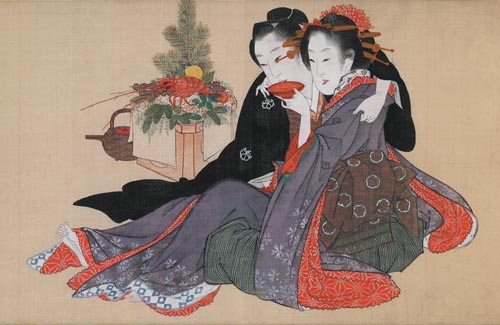Exhibit toys with lust in the art of seduction

But the Hwajeong Museum in Pyeongchang-dong, Seoul, invites viewers to indulge in their inner voyeur while contemplating the difference between art and erotica in the exhibit “Lust,” featuring 114 erotic paintings and objects from Korea, China and Japan.
Hwajeong is famous for its collection of Chinese and Tibetan art. It also holds works from Korea and other Asian countries, but this is its first survey of erotic art.
“The demand for, and supply of, erotic art, was constant but the works could not be made public,” said museum director Han Hye-ju. “The erotic paintings in the exhibit are approached as art and items of academic value.”
But despite their classification as high art, the works in the exhibit contain some very provocative scenes. Some are merely suggestive of sex, while others are more explicit.
Bare bodies pile together in one work and a couple sits astride a horse in another. In one of the more unambiguous pieces, a woman pleasures herself with the aid of an adult toy. Another piece makes us party to an illicit affair.
In the erotic paintings from China, the figures do not fill the canvas. These works have more in common with genre paintings - except for the naked figures. One such painting is set in front of a Buddhist altar. It depicts a man reaching out to touch a kneeling woman’s feet, showing that foot fetishism has no bounds.

These erotic paintings from Japan, top, and China are the tamest works in the ‘Lust’ exhibition at the Hwajeong Museum, which runs through Dec. 19. Due to the explicit nature of the art on display, the exhibit is only open to visitors 19 years of age and older. [YONHAP]
The exhibit does not limit itself to two-dimensional works. A liquor glass molded into a shape suggesting foot-binding and a sculpted penis are also on display.
Some of the works in the exhibit once had a function beyond their overtly erotic imagery.
“In 19th century China and Japan, keeping erotic paintings in the house was thought to guard against fire, and erotic paintings were given to daughters as part of the wedding trousseau,” said researcher Kim Ok-in.
The Japanese paintings in the exhibit feature bold close-ups of couples making love with exaggerated sexual organs. This is in stark contrast to the Chinese and Korean paintings, where the figures sit quietly in the background.
Erotic art became popular in Japan after the introduction of ukiyo-e (pictures of the floating world) woodblock prints in the Edo period.
At first, it’s hard not to blush while going through the exhibit, but some of the works contain touches of humor that help take the tension away. Katsushika Hokusai’s (1760-1849) painting, for example, shows a post-coital couple sleeping as a cat watches two mice mating.
“Everlasting Spring” by Shin Yun-bok is one of the few Korean pieces in the exhibit, on loan from the National Museum of Korea.
The painting shows two pairs of shoes placed outside a closed door and a confused female servant standing nearby carrying a tray of food and drinks. It is a poetic painting that invites the audience to picture the unknown.
The section called Secretum exhibits Western erotica. The title refers to the room housing early 19th-century erotic art at the British Museum and another room with a similar collection at the Naples National Archeological Museum.
The museum will host a series of lectures on Oct. 2 to put all of the art in context. Speakers include Professor Hong Sun-pyo of Ewha Womans University, Professor Hayakawa Monta of The Japan Foundation in Seoul and Professor Timon Screech of the University of London.
*The exhibit ends Dec. 19. Hours are 10 a.m. to 6 p.m. Tuesdays to Sundays. Tickets are 5,000 won (4.31 dollars). Take bus No. 110, 153, 1020, 1711 or 7211 toward Jeongneung and get off at Hwajeong Museum. For details, call (02) 2075-0123 or visit www.hjmuseum.or.kr.
By Lee Kyung-hee [estyle@joongang.co.kr]










with the Korea JoongAng Daily
To write comments, please log in to one of the accounts.
Standards Board Policy (0/250자)